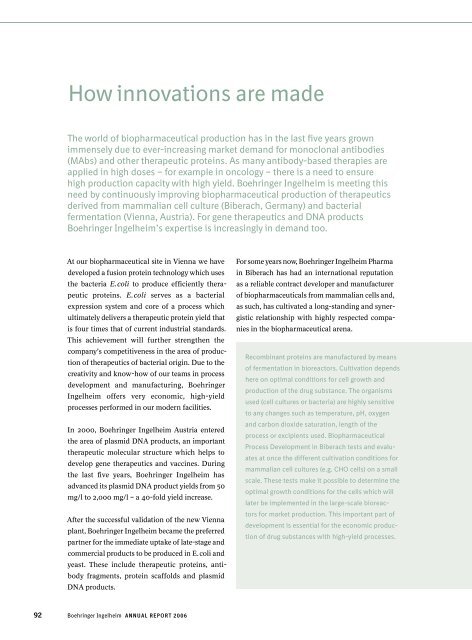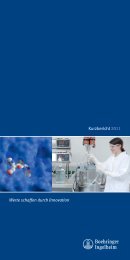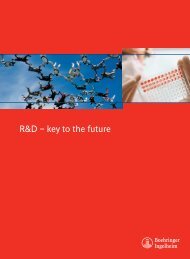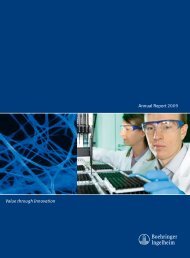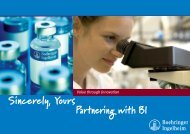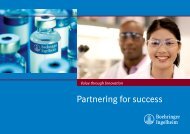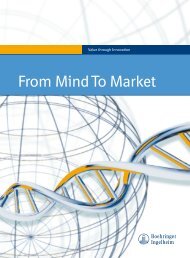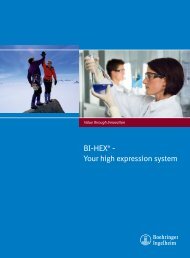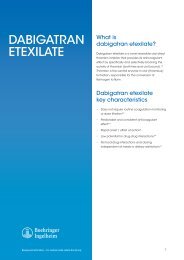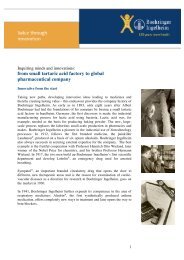Annual Report 2006 - Boehringer Ingelheim
Annual Report 2006 - Boehringer Ingelheim
Annual Report 2006 - Boehringer Ingelheim
You also want an ePaper? Increase the reach of your titles
YUMPU automatically turns print PDFs into web optimized ePapers that Google loves.
9<br />
How innovations are made<br />
The world of biopharmaceutical production has in the last five years grown<br />
immensely due to ever-increasing market demand for monoclonal antibodies<br />
(MAbs) and other therapeutic proteins. As many antibody-based therapies are<br />
applied in high doses – for example in oncology – there is a need to ensure<br />
high production capacity with high yield. <strong>Boehringer</strong> <strong>Ingelheim</strong> is meeting this<br />
need by continuously improving biopharmaceutical production of therapeutics<br />
derived from mammalian cell culture (Biberach, Germany) and bacterial<br />
fermentation (Vienna, Austria). For gene therapeutics and DNA products<br />
<strong>Boehringer</strong> <strong>Ingelheim</strong>’s expertise is increasingly in demand too.<br />
At our biopharmaceutical site in Vienna we have<br />
developed a fusion protein technology which uses<br />
the bacteria E. coli to produce efficiently therapeutic<br />
proteins. E. coli serves as a bacterial<br />
expression system and core of a process which<br />
ultimately delivers a therapeutic protein yield that<br />
is four times that of current industrial standards.<br />
This achievement will further strengthen the<br />
company’s competitiveness in the area of produc-<br />
tion of therapeutics of bacterial origin. Due to the<br />
creativity and know-how of our teams in process<br />
development and manufacturing, <strong>Boehringer</strong><br />
<strong>Ingelheim</strong> offers very economic, high-yield<br />
processes performed in our modern facilities.<br />
In 2000, <strong>Boehringer</strong> <strong>Ingelheim</strong> Austria entered<br />
the area of plasmid DNA products, an important<br />
therapeutic molecular structure which helps to<br />
develop gene therapeutics and vaccines. During<br />
the last five years, <strong>Boehringer</strong> <strong>Ingelheim</strong> has<br />
advanced its plasmid DNA product yields from 50<br />
mg/l to 2,000 mg/l – a 40-fold yield increase.<br />
After the successful validation of the new Vienna<br />
plant, <strong>Boehringer</strong> <strong>Ingelheim</strong> became the preferred<br />
partner for the immediate uptake of late-stage and<br />
commercial products to be produced in E. coli and<br />
yeast. These include therapeutic proteins, antibody<br />
fragments, protein scaffolds and plasmid<br />
DNA products.<br />
<strong>Boehringer</strong> <strong>Ingelheim</strong> A n n u A l R e p o R t 2 0 0 6<br />
For some years now, <strong>Boehringer</strong> <strong>Ingelheim</strong> Pharma<br />
in Biberach has had an international reputation<br />
as a reliable contract developer and manufacturer<br />
of biopharmaceuticals from mammalian cells and,<br />
as such, has cultivated a long-standing and synergistic<br />
relationship with highly respected companies<br />
in the biopharmaceutical arena.<br />
Recombinant proteins are manufactured by means<br />
of fermentation in bioreactors. Cultivation depends<br />
here on optimal conditions for cell growth and<br />
production of the drug substance. The organisms<br />
used (cell cultures or bacteria) are highly sensitive<br />
to any changes such as temperature, pH, oxygen<br />
and carbon dioxide saturation, length of the<br />
process or excipients used. Biopharmaceutical<br />
Process Development in Biberach tests and evaluates<br />
at once the different cultivation conditions for<br />
mammalian cell cultures (e.g. CHO cells) on a small<br />
scale. These tests make it possible to determine the<br />
optimal growth conditions for the cells which will<br />
later be implemented in the large-scale bioreactors<br />
for market production. This important part of<br />
development is essential for the economic production<br />
of drug substances with high-yield processes.


